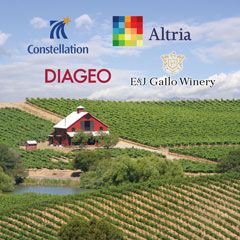
California has hundreds of small, family-owned wineries surrounded by vineyards. But the huge international companies that dominate the industry also trade on that image to promote their products, and their business interests.
 Marin Institute Research and Policy Director Sarah Mart says their study of the biggest multinational figures in the US and California wine industry also dominate the California Wine Industry.
Marin Institute Research and Policy Director Sarah Mart says their study of the biggest multinational figures in the US and California wine industry also dominate the California Wine Industry.

In the wake of prohibition, the alcoholic beverage industry in the United State was organized into three separate branches: supply and production, distribution and wholesaling, and retail sales. Having substantially consolidated the ownership and production of wine in California, these multi-billion companies are now turning their attention to another branch of the industry, Mart says, and moving to assert their dominance over distribution.
 Sarah Mart is the Research and Policy Manager at Marin Institute. You can read a summery or download here entire report here. Find out more about the California Wine Institute at their website.
Sarah Mart is the Research and Policy Manager at Marin Institute. You can read a summery or download here entire report here. Find out more about the California Wine Institute at their website.

Rachel Carson may have been America’s first environmental whistle-blower. That’s inspired for a west county poet to create her own biographical one-woman show about the author of Silent Spring.

Lilith Rogers describes herself as a lifelong gardener and poet—she’s even written a book of her own about horticulture in western Sonoma County—but she got the spark of an idea about doing something new when she saw a one-woman show about Alberta King, the mother of Martin Luther King, at Santa Rosa Junior College. So Rogers began casting about for a subject that she might take on for a similar presentation.
 One reason that Silent Spring had such an immediate and widespread impact when it was published, explains Lilith Rogers, was that the book offered a clear and well-documented explanation that linked a number of troubling events that were readily observable in the American environment.
One reason that Silent Spring had such an immediate and widespread impact when it was published, explains Lilith Rogers, was that the book offered a clear and well-documented explanation that linked a number of troubling events that were readily observable in the American environment.
Rachel Carson and Silent Spring were a media sensation, too, by the standards of 1962. Rogers says the flavor of that fascination, and the some of the now-discredited attitudes that were prevalent then, could be seen in an exchange that was broadcast on national television on the prominent CBS Reports program.
 Doing the one-woman show offers a way for Carsons’ voice to be heard again today, as in this excerpt from Rachel Carson Returns in which Rogers reads from the final chapter of Silent Spring.
Doing the one-woman show offers a way for Carsons’ voice to be heard again today, as in this excerpt from Rachel Carson Returns in which Rogers reads from the final chapter of Silent Spring.


The formerly endangered California Brown Pelican appears to be facing some new challenges this winter, as hundreds of the birds have been taken to bird rescue facilities from here to Long Beach.

Paul Kelway, a spokesman for the International Bird Rescue Research Center, says that after several days of feeding and cleaning, many of the bedraggled birds have been successful released into the wild again.
The IBRRC website maintains updated counts of the pelicans that have successfully been treated and released.

Despite their name, California Brown Pelicans can also be gray, white or combinations of all three colors. Nor is their natural range confined to the Golden State. In fact, as Paul Kelway explains, they migrate up and down much of the Pacific coast, which is part of the reason they’ve had problems recently.

These birds, the smallest of all pelican species, were placed on the Endangered Species list because exposure to DDT resulted in thinner shells for their eggs, which led to fewer birds hatching, and reduced birth rates. Since the pesticide was banned, the pelican population has been gradually rebounding. The group seen at right are regaining their strength at the IBRRC facility in Cordelia, near Fairfield.
 It may take a lifetime to see the results, but students replanting a native oak forest near Glen Ellen are taking the long view.
It may take a lifetime to see the results, but students replanting a native oak forest near Glen Ellen are taking the long view.
 Bouverie Preserve
Bouverie Preserve
 Sonoma Valley High School
Sonoma Valley High School
 California’s 1 million farmworkers are at increased risk for respiratory diseases and other health problems, according to a new report, in large part due to poor air quality where they are working.
California’s 1 million farmworkers are at increased risk for respiratory diseases and other health problems, according to a new report, in large part due to poor air quality where they are working.

Pesticides and other chemicals are part—but only part—of the air quality issues that affect farm workers, especially in California’s Central Valley. So even the most basic measures to shield workers from the worst of the dust and smog can make a significant contribution to protecting their respiratory health, says Marc Schenker (right), Director of the Center for Agricultural Health and Safety at the University of California at Davis.


 Live Radio
Live Radio